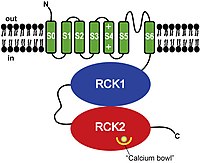
Photo from wikipedia
The artificial synapses are basic units in the hardware implementation of neuromorphic computing, whose performances should be gradually modulated under external stimuli. The underlying mechanism of the increasing and decreasing… Click to show full abstract
The artificial synapses are basic units in the hardware implementation of neuromorphic computing, whose performances should be gradually modulated under external stimuli. The underlying mechanism of the increasing and decreasing device conductance is still unclear in the Hf0.5Zr0.5O2 based synapses. In this study, the Hf0.5Zr0.5O2 capacitors with different stack orders are fabricated in atomic layer deposition, whose ferroelectric properties are investigated by analyzing the capacitance–voltage and polarization-voltage curves. The enhanced ferroelectricity is found after the rapid thermal annealing treatment for all the TiN/Hf0.5Zr0.5O2/TiN, TiN/HfO2-ZrO2/TiN and TiN/ZrO2-HfO2/TiN devices. In the device with poor ferroelectricity, the conductance gradually decreases under both positive and negative identical pulse schemes, which corresponds to the gradual dissolution process of the conductive filaments established in the initial pulse. For the capacitors with strong ferroelectricity, dual-direction conductance modulation can be observed due to the partial domain switching process, which can emulate the potentiation and depression process of biological synapses.
Journal Title: Nanotechnology
Year Published: 2022
Link to full text (if available)
Share on Social Media: Sign Up to like & get
recommendations!